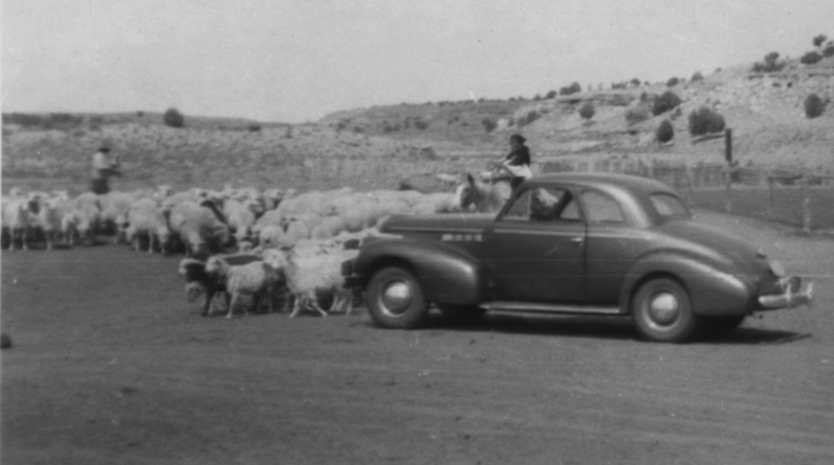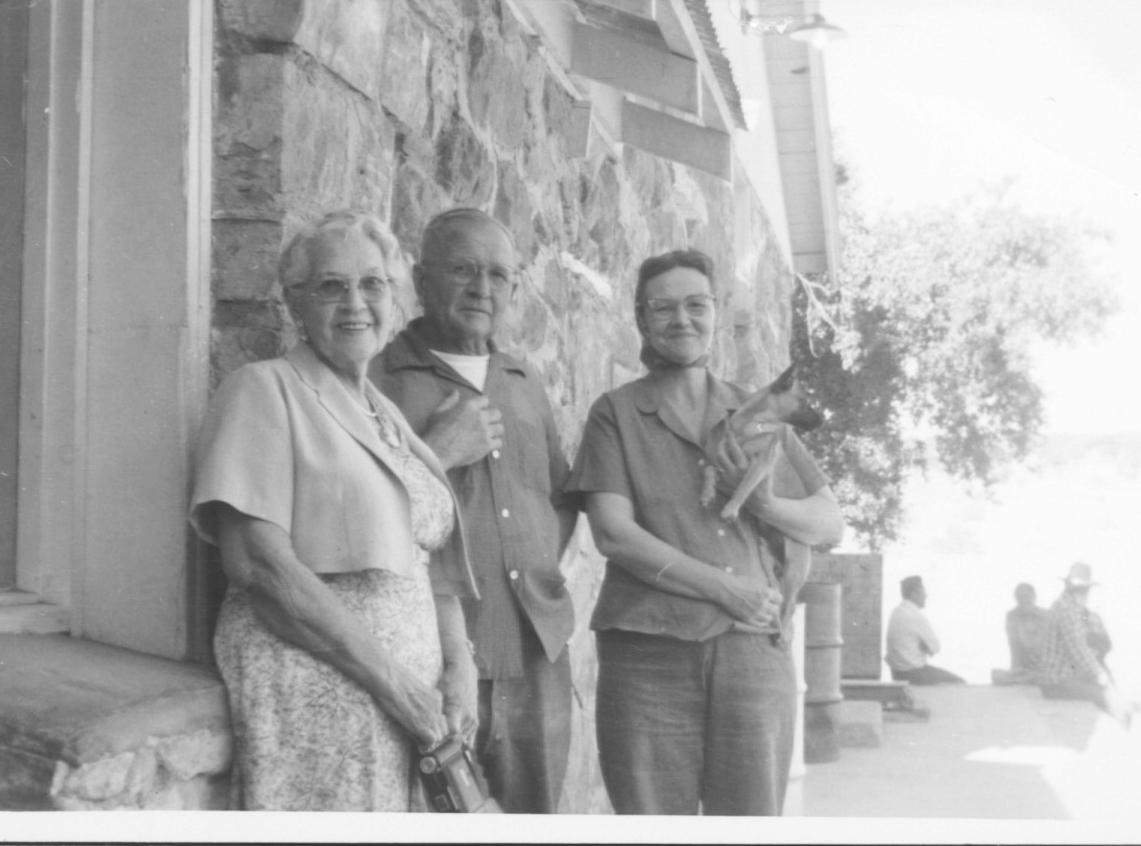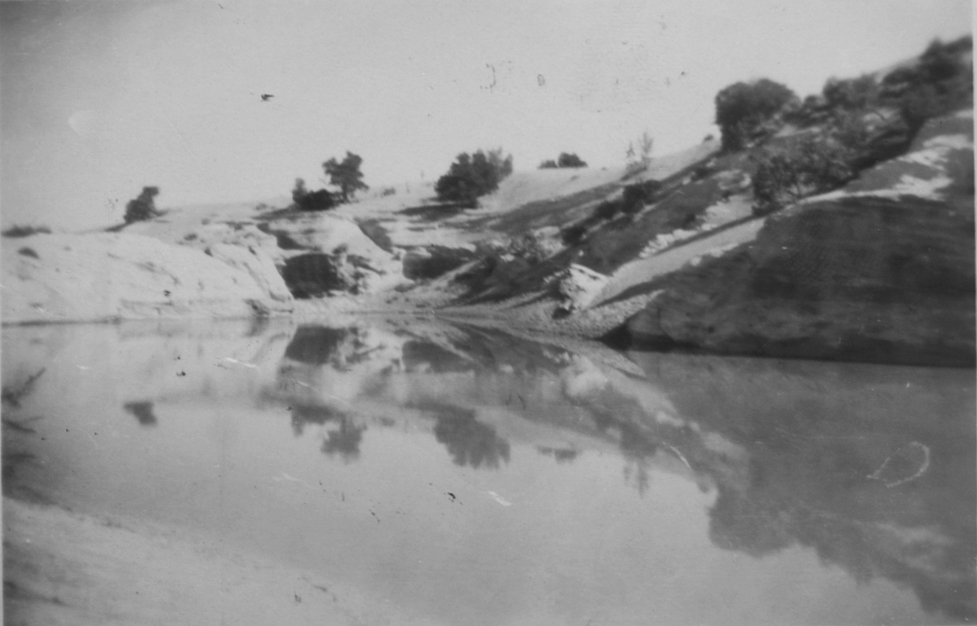PICTURES AND CAPTIONS FOR KAIBETO MEMORIES
by Elizabeth Anne Jones Dewveall
click for Kaibeto start page
click for color photos of Anne at Kaibeto (kaiebeto 1)
clik for photos of Kabeto (kaibeto2)
See maps and clippings of Kaibeto: kaibeto3
It is important that Elizabeth Anne review these photos and especially their captions to ensure accuracy.
I have personally evaluated these images by Must Include (17), Like to Include (4), and May Include (8). Final choices may be made based on available space versus these categories, with the Must Include catgergory having space dedicated for it, with other catgegories being more dependent on space that might otherwise be blank due to layout issues. Some of my choices were based on how well they supported captions that were most relevant to Elilzabeth Ane's memories.
Front cover
 Must Include
Must Include
KAIBETO MEMORIES
by Elizabeth Anne Jones Dewveall,
Story of a trader's daugter growing up on the Navajo Indian Reservation at Kaibeto Trading Post in northeastern Arizona, 1936-1960s

Sacks of wool stacked 4+ high—each weighing
200 pounds—from sheep at shearing season of spriong 1953, awaiting transport from Kaibeto

Trader
Ralph Jones posing at a sign telling how far it is to go on dirt/sand or rock roads like the
one under the Buick, his favorite car.
And uncharacteristically dressed up, Elizabeth Anne notes.

 possibly to go beside title on title page
possibly to go beside title on title page
Elizabeth
Anne in her Navajo dress, belt, and necklace posing at the Kaibeto gas pump for a 1939 Standard Oil Company
ad, the gasoline available at the trading post.
[The Standard Oil Company brochure in which this is the inside back cover notes it is not copyrighted. (not part of the caption) ]
.
 May Include
May Include
Warehouse storage space at the side of Kaibeto Trading Post, rodky bluff behind. Trading store entrance is out of sight on the right. Shows trading post after 1953 remodel.
 Must Include
Must Include
Above photo will go on back cover with this caption right below and then the back cover blurb below that.
Traders
Ralph and Julia Jones at Kaibeto Trading Post, Buick in view.
(Raph had the title, but operaton of the
post was a cooperative undertaking.)
Back cover blurb:
TRADERS TO THE NAVAJO
Ralph Jones and his wife Julia operated the Kaibeto Trading Post on the Navajo Indian Reservation for 28 years, from1934 to1962, in northeastern Arizona. Theirs was a time when roads in the area were more like paths in the sand and over rocky ridges--snow-covered in winter--as the Native population was beginning to transition from horseback and wagon travel to pickup truck while still dealing with flash floods in otherwise dry washes. The pos's role was to provide goods that were needed by the local population to supplement the meager resources this harsh land could provide. Canned fruits and meats were important articles, as were tobacco and knives. The Natives traded sheep hides, wool, woven blankets, and turquoise-laden silver jewelry for the goods brought to the post for them. Their jewelry often was provided as collateral, "pawn" to pay for purchases. Ralph and Julia and daughter Elizabeth Anne were often the only people of their "white-person" race in the entire region.
It was in this environment that author Elizabeth Anne lived her childhood years. Her playmates were often from the local population and as she tells in these "Kaibeto Memories" included some who became artists and leaders of their people. In her later childhood years her school times were spent living with Aunt Zada (Ralph's sister) and Uncle John Purdy along with their children Rosemary and Suzanne in distant Winslow, Arizona, but coming back to what she calls, affectionately it is believed, the "Rez" for holidays and summer vacations.
And so this is Elizabeth Anne's story, told as an adult in the year 2020 while living at Mesa, Arizona, As she points out her purpose in recording her story is even more for it to be her parents' story, for there is scant material about their lives at Kaibeto and how they operated this out-of-the-way and now-historic trading post for many years as a life-hub for a receptive Native population. "Intriguing", as one museum curator called Eiizabeth Anne's memories..

A
trader family dressed in "going to town" clothes for a 1940 trip to Flagstaff; Elizabeth Anne in cowboy boots.

Elizabeth Anne holding Daddy’s hand, while Ralph
is in his typical "uniform” for a busy trader who was merchant, warehouseman, mechanic, and more.
1943.

Navajo
men found the vicinity of the post a place to gather. (faces masked for privacy) At least the man in front
wears a sidearm and bullet belt.

Mamaw,
Ralph’s mother, with Elizabeth Anne and "Eddie Girl" a favorite dog, perched at the edge of
the bluff that is behind the trading post. At or very near this same spot, Eddie Girl was later bitten by a rattlesnake that was under this or a similar rock. Mamaw was Elizabeth Jones (in this picture, Self) and had earlier been employed
at Cameron Trading Post on the Little Colorado River. She and 5 of her 7 children moved as adults from Indiana to this part of Arizona, and several stayed their
whole lives. It was at Cameron where Ralph met Julia, who was also working
there, and.
“Little
Ralph” named for Ralph by a father appreciative of the trader’s kindness and support.
 Must Include
Must Include
Interior of Kaibeto Traing Post (1948?) showing trading center where Indians would stand and call out or point to the goods on the shelves that they wanted. Ralph entertained them when they called for an item on a high shelf by pushing it with a long stick off its ledge to fall and then catching it on its way down. Popular items were tobacco cut in plugs and soda pop, served warm. The cabinets held Native jewelry brought in for pawn in exchange for trade goods. Hand-woven blankets were also traded, often in the form of saddle blankets, and were created in a style reflecting origin at Kaibeto. The doorway to the post living quarters is seen as an opening near the center of the picture.
 Must Include (may be tilted as below)
Must Include (may be tilted as below)
Here at Kaibeto Trading Post is where Elizabeth Anne spent much of the time of her childhood. The house where she lived, obscured here by trees, was attached on the right to the trading postt. An interior doorway passed directly from the house to the trading area. The main entrance to the trading area, flanked by windows on each side, shows in the center of the more prominent building. The structure on the left is the warehouse for storing supplies and traded merchandise such as hides. This picture is a bit unusual in that it was not uncommon to see in the view here not only horses, but wagons and even a pickup. Natives might also linger, socialize, or play card games before or after their trading activity, sometimes all day. (August 1948)
 Must Include
Must Include

The
hitching post tree in front of the trading post where horses could be tied while their riders shopped, or lilngered. (face masked for privacy) Notice the
sidearm, but there was never any trouble at Kaibeto during Elizabeth Anne's time although that was not the case at all posts.
. Like to Include
Like to Include
Julia, as a young maried in 1934, waiting as the trading post is remodeled.

Elizabeth
Anne and mother Julia, posing near hitched horses, 1943, in their typical "uniform' for working in the trading post.

Mother
Julia has caught a fish at a rare desert lake on Kaibito Creek at some distance from Kaibito Trading
Post, but worth the drive through desert and sand for some recreation and time
away from a post that was, as Elizabeth Anne has noted, "a sunrise-to-sunset, all-week long venture". Not to mention
a chance for some fresh food from a diet largely of canned products
from the post’s supply.

Sheep
were a mainstay in the region’s economy.

Frenchman’s
Lake, with a fisherman. Late 1940s. The origin of this
lake on Kaibito Creek and its name are unclear but its
demise was when the creek raged in flood and took out its dam.

close-up of angler above.

Elizabeth
Anne, a single child, had many doll playmates and posed them here beside her
trading post home.
 Must Include
Must Include
Elizabeth Anne is giving her dog "Lollipop the Terrible" a
bath in a tub, the same tub and same way the family did their weekly laundry until Elizabeth Anne's freshman year in high school when electrity allowed a washing machine. Before that, evening lighting was with kerosene lamps and the refrigerator used that fuel, too.

Elizabeth Anne in her native dress and belt,
at the side of her house on the reservation, holding hands with two probably local girls
 Must Include
Must Include
Kai Peto Springs is labeled on this part of an 1886 map of the region. (After a few editions of this map the name changed to Kaibito Springs and that name still appears on maps today.) Except for scarce springs in otherwise vast waterless areas, there are few place names on even the larger map this one is part of. That may be why four trails wih two nearby junctions are shown to converge on this water source. The map shows a trickle of water flowing northward toward the spot where Kaibeto Trading Post was founded circa 1914. The English name for Kaibito Springs is slightly redundant, for according to Navajo tradition and modern use by the nation for this governmental regon, Kaibito means “willow in the water”. Although automobiles began appearing in the area as early as 1920, it was decades before existing tracks became real roads, and certainly not during most of the time that Elizabeth Anne was growing up.
A note on the name Kaibeto/Kaibito and how to spell it where. Navajo words are spoken and were initially not written. This may explain why different spellings got attached to different places. And so we have Kabito Creek, Kaibito springs, kaibito Plateau, and other "Kaibitos". Yet Kaibeto Trading post from far back in time has been spelled its way. The Kaibeto Indian School also used the same form as the trading post. Here the separate spellings that have beenb traditionally applied to separate features have been used.

Elizabeth
Anne did not attend the Kaibeto Indian School but instead stayed with her aunt
Zada in Winslow, Arizona, attending school there or in nearby Leupp. She went
home to Kaibeto during school holidays and summer vacations. Here is one letter
she reecieved from her parents that gives an idea of the “normal” challenges
they dealt with routinely. This news was sent to her on September 25, 1952 via
a 3 cent United States postage stamp:
Dear
Anne…Tthe sheep are coming in awful slow this year.We have been buying two
weeks now and we are only about half finished according to the count. The roads
are all washed out in all directions which has something to do with it. We went
three full days without any cars getting into the store. I’ve been just about
down with my back for two weeks and your mother isn't so hot either but guess
we will make it somehow. And that’s about all for this time…Parents


Below item can be a call-out on a page or as part of the picture gallery: Must Include
CHRISTMAS
Eliazbeth Anne has described her 5th Christmas tree (1940): The base used for the tree was sheep salt, likely from the trading post's stash kept for supplying that mineral for licking by flocks kept by Native herders. These salt blocks were about a foot square with a hole in the center.
Elizabeth Anne notes, "My father made Ebeneezer Scrooge seem like Santa Claus. Every Christmas he griped and grouched for a week because mother and I had to have a tree. Then he waited until there was a foot of snow on the ground before beginning his search, never an easy chore, even in decent weather.
After spending laboriious hours trying to anchor the thing and make it stand straight (an impossibility with scrub cedar), he departed for the haven of the trading post, leaving Mother and me to go to all that 'fool trouble' of decorating,
Once we had accomplished our part, he spent the next two weeks escorting every Navajo from Red Lake to Inscription Houjse into our home to view 'his' creation."
--exerpted from Arizona Republic, January 7, 1988
. May Include
May Include
Ralph at 66 years, Julia at 56 years, Mammaw Jones/Self at 82 years visiitng at the Kaibeto Trading Post in 1956, 22 years after their adventure began, with still another 6 years to go.
 .May Include
.May Include
Frenchman Lake on Kaibito Creek, some distance over rough roads from the trading post but offering a respite from chores and a chance for having fresh food if fishing was lucky. Elizabeth Anne said "Daddy called it Frenchman's Puddle" but it had big bass and lots of bluegill perch.